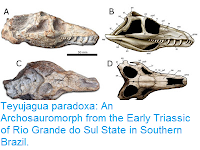Live birth is found in all living Mammals except Monotremes, as well as in over a hundred different species of Snakes and Lizards. It has also been recorded in a variety of Mesozoic Marine Reptiles, notably the Eosauropterygians, Ichthyosaurs, Mosasauroids, Choristoderans, and Probably the Mesosaurs. This suggests that there are strong advantages for Amniotes (Vertebrates which keep their young in a water-tight sack, either within the egg or the mother) in adopting this strategy. However there are two living groups in which it is not observed, the Archosaurs (Birds plus Crocodilians) and the Testudines (Turtles). The absence of live birth in Turtles is easy to explain; the bony shell would make it impossible to give birth to a large, precocious baby, so many small eggs is likely to be the best strategy in this group. The Archosaurs are more difficult to explain; the constraints of flight probably make external development of the young a good strategy for Birds (though Bats give birth to live young), but this does not apply to Crocodilians, and of the numerous Dinosaurs in which the reproductive method is known, all laid eggs, leading to speculation that there is some fundamental reason why Archosaurs cannot produce live young.
In a paper published in the journal Nature Communications on 14 February 2017, Jun Liu of the School of Resources and Environmental Engineering at the Hefei University of Technology, the Chengdu Center of the China Geological Survey and the State Key Laboratory of Palaeobiology and Stratigraphy at the Nanjing Institute of Geology and Palaeontology, Chris Organ of the Department of Earth Sciences at Montana State University, Michael Benton of the School of Earth Sciences at the University of Bristol, Matthew Brandley of the School of Life and Environmental Sciences at the University of Sydney and Jonathan Aitchison of the School of Earth and Environmental Sciences at the University of Queensland, describe a specimen of the Middle Triassic Archosauromorph, Dinocephalosaurus orientalis, from the Louping Biota of Yunnan Province, China.
An Archosauromorph is any animal more closely related to the Crocodilians and Birds than it is to anything else, while an Archosaur proper is any animal descended from the last common ancestor of Crocodilians and Birds. Archosauromorphs first appeared in the Permian, and reached their maximum diversity in the Triassic. Dinocephalosaurus orientalis was a Protosaur; a type of aquatic Archosauromorph. It appears to have been highly specialised for an aquatic lifestyle, with large, paddle-like limbs and an elongate neck, which would have made it very difficult for the animal to manoeuvre on land. This species is the only Marine Reptile known from the Louping Biota, a fossil Lagerstätte producing a diverse and well preserved middle-shelf fauna from about 244-245 million years ago, which outcrops across much of South China, taking its name from Louping County in Yunnan Province, where some of the best outcrops of these strata are found, and where this specimen comes from.
The specimen described by Lui et al. is a partial adult skeleton, with what appears to be an embryonic skeleton of the same species within its abdominal cavity. This is interpreted as being a developing embryo in situ for two reasons; firstly it is entirely within the body cavity, strongly suggesting that this is not two specimens coincidentally overlaying one-another, and secondly it is in a head-forward position within the cavity, which is usual for embryos, but unusual for the swallowed prey of large, aquatic vertebrates, which are usually swallowed head-first; this is supported by the presence of a large Fish, also within the body cavity, which is preserved in a tail-backwards position.
See also...
Skeleton of the new Dinocephalosaurus specimen. (a) Photograph. The three separate blocks are arranged following their original positions in the field. (b) Interpretive drawing. Dotted line indicates the rough course of the vertebral column of the adult. The different colour in the cervical region aims to facilitate the association of cervical ribs with corresponding vertebrae. (c) Photo showing a close-up of the embryo preserved in the stomach region. (d) Interpretive drawing of the embryo. (e) Photo showing a close-up of the perleidid fish preserved in the stomach region. (f) Artist’s reconstruction of Dinocephalosaurus showing the rough position of the embryo within the mother. ax, axis; car, caudal rib; crh, cervical rib head; cv, cervical vertebrae; d4, fourth digit; f, perleidid fish; fe, femur; fi, fibula; h, humerus; ha, haemal arch; m, mandible; mt1, metatarsal 1; mt5, metatarsal 5; poz, postzygapophysis; prz, prezygapophysis; ra, radius; ti, tibia; ul, ulna. Scale bar, 20 cm. Lui et al. (2017).
See also...
Follow Sciency Thoughts on Facebook.







